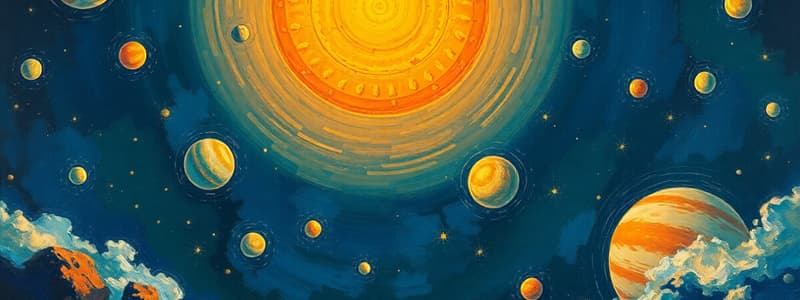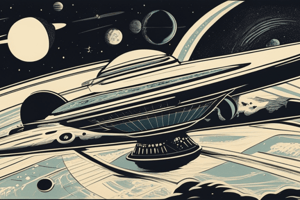Podcast
Questions and Answers
Which planet is known for having a giant storm called the Great Red Spot?
Which planet is known for having a giant storm called the Great Red Spot?
- Jupiter (correct)
- Saturn
- Neptune
- Uranus
What primarily composes the atmosphere of gas giants like Jupiter and Saturn?
What primarily composes the atmosphere of gas giants like Jupiter and Saturn?
- Water and ammonia
- Hydrogen and helium (correct)
- Methane and carbon dioxide
- Oxygen and nitrogen
Which planet is characterized by a significant presence of methane, giving it a cyan color?
Which planet is characterized by a significant presence of methane, giving it a cyan color?
- Jupiter
- Saturn
- Neptune
- Uranus (correct)
What distinguishes ice giants like Uranus and Neptune from gas giants?
What distinguishes ice giants like Uranus and Neptune from gas giants?
What is the classification of the four outer planets in our Solar System?
What is the classification of the four outer planets in our Solar System?
What is the primary feature that separates Saturn from Jupiter?
What is the primary feature that separates Saturn from Jupiter?
Which planet has more active and visible weather patterns compared to Uranus?
Which planet has more active and visible weather patterns compared to Uranus?
What term is used to describe natural satellites that orbit planets?
What term is used to describe natural satellites that orbit planets?
What is the primary composition of the Sun's mass?
What is the primary composition of the Sun's mass?
Which of the following planets is known for having a dense atmosphere with extensive volcanism?
Which of the following planets is known for having a dense atmosphere with extensive volcanism?
What percentage of the Solar System's mass does the Sun comprise?
What percentage of the Solar System's mass does the Sun comprise?
What characteristic defines terrestrial planets within the Solar System?
What characteristic defines terrestrial planets within the Solar System?
Which planet is the closest to the Sun?
Which planet is the closest to the Sun?
Which of these statements is true about Mars?
Which of these statements is true about Mars?
How do planets in the Solar System orbit the Sun?
How do planets in the Solar System orbit the Sun?
Which of the following planets is known as an ocean world?
Which of the following planets is known as an ocean world?
What primarily composes Io, one of Jupiter's moons?
What primarily composes Io, one of Jupiter's moons?
Which of the following moons is known for having a substantial atmosphere?
Which of the following moons is known for having a substantial atmosphere?
What distinguishes a dwarf planet from a regular small body?
What distinguishes a dwarf planet from a regular small body?
What is the main composition of bodies found in the trans-Neptunian region?
What is the main composition of bodies found in the trans-Neptunian region?
Which characteristic applies to the majority of asteroids in the asteroid belt?
Which characteristic applies to the majority of asteroids in the asteroid belt?
What primarily constitutes Saturn's rings?
What primarily constitutes Saturn's rings?
Which statement accurately describes Ceres?
Which statement accurately describes Ceres?
What is the primary feature of the Kuiper belt compared to the asteroid belt?
What is the primary feature of the Kuiper belt compared to the asteroid belt?
What primarily influenced the formation of a spinning protoplanetary disc?
What primarily influenced the formation of a spinning protoplanetary disc?
What process describes how planets formed from dust grains in the protoplanetary disc?
What process describes how planets formed from dust grains in the protoplanetary disc?
Which type of planetesimals formed in the inner Solar System?
Which type of planetesimals formed in the inner Solar System?
What role did the solar wind play during the formation of the Solar System?
What role did the solar wind play during the formation of the Solar System?
Which planets are thought to have formed after Jupiter and Saturn?
Which planets are thought to have formed after Jupiter and Saturn?
What was the main reason for the small size of terrestrial planets?
What was the main reason for the small size of terrestrial planets?
What happened to the gas and dust in the protoplanetary disc at the end of the planetary formation epoch?
What happened to the gas and dust in the protoplanetary disc at the end of the planetary formation epoch?
How did planetesimals grow into larger bodies?
How did planetesimals grow into larger bodies?
What is the largest body in the asteroid belt?
What is the largest body in the asteroid belt?
Which of the following objects is classified as a dwarf planet?
Which of the following objects is classified as a dwarf planet?
What is the primary reason for the extreme orbits of scattered-disc objects?
What is the primary reason for the extreme orbits of scattered-disc objects?
Which object was the first extreme trans-Neptunian object discovered?
Which object was the first extreme trans-Neptunian object discovered?
What does the nebular hypothesis suggest about the formation of the Solar System?
What does the nebular hypothesis suggest about the formation of the Solar System?
What primarily constituted the mass of the presolar nebula from which the Solar System formed?
What primarily constituted the mass of the presolar nebula from which the Solar System formed?
What effect does the conservation of angular momentum have on a collapsing nebula?
What effect does the conservation of angular momentum have on a collapsing nebula?
What happens to the temperature at the center of the nebula as it collapses?
What happens to the temperature at the center of the nebula as it collapses?
Flashcards are hidden until you start studying
Study Notes
Solar System Overview
- The Solar System is a gravitationally bound system consisting of the Sun and various celestial objects that orbit it.
- Key components include the Sun, planets, moons, dwarf planets, and small bodies.
The Sun
- Positioned at the center of the Solar System, the Sun is a nearly perfect sphere composed mostly of hydrogen (approximately ¾ of its mass), with helium being the second most abundant element.
- Represents 99.86% of the total mass in the Solar System.
- Nuclear fusion occurs in the Sun’s core, converting hydrogen to helium and releasing vast amounts of energy in the form of electromagnetic radiation.
Planets
- Planets orbit the Sun in a direction consistent with Earth's orbital plane.
- Mercury: Closest planet, characterized by a heavily cratered surface.
- Venus: Second planet, known for a dense atmosphere and significant volcanism.
- Earth: The third planet, unique for its liquid surface water and supportive atmosphere.
- Mars: Fourth planet, featuring volcanoes, rift valleys, and polar ice caps.
Terrestrial vs. Giant Planets
- Terrestrial planets (Mercury, Venus, Earth, Mars) have dense, rocky compositions.
- Giant planets are categorized further: Jupiter and Saturn are gas giants, while Uranus and Neptune are classified as ice giants, consisting largely of volatile compounds.
Notable Features of the Gas Giants
- Jupiter: Fifth planet, known for its distinct atmospheric bands and the Great Red Spot, a massive storm.
- Saturn: Sixth planet, recognized for its pronounced rings and fainter atmospheric bands.
- Uranus: Seventh planet, notable for its cyan color due to methane in its atmosphere.
- Neptune: Eighth planet, features vibrant weather patterns unlike its neighbor Uranus.
Moons and Satellites
- Most planets have natural satellites (moons); Earth has one significant moon, while Jupiter boasts 95 known moons.
- Saturn has 146 moons, with Titan being the largest and the only moon with a substantial atmosphere.
Dwarf Planets and Small Bodies
- Dwarf planets like Ceres (largest in the asteroid belt) and Pluto (largest in the Kuiper belt) are key players.
- The asteroid belt lies between Mars and Jupiter, containing numerous rocky and metallic objects.
- The Kuiper belt extends beyond Neptune, filled with small, icy bodies.
Formation of the Solar System
- The nebular hypothesis is the leading theory for the Solar System's formation, positing that it originated from the gravitational collapse of a giant molecular cloud.
- The early Solar System, comprised mostly of hydrogen and helium, began to spin and heat up due to gravitational forces.
- A protoplanetary disc formed, and planets were created through the process of accretion from dust grains.
Planet Formation
- Inner Solar System's rocky planets formed from metal and silicate compounds due to higher temperatures, while icy bodies beyond the frost line coalesced into the giant planets (Jupiter and Saturn) as they attracted significant amounts of hydrogen and helium.
- The young Sun's solar wind expelled gas and dust, affecting the growth of planets, particularly Uranus and Neptune.
- Protoplanets merged to form terrestrial planets, but their growth was hindered due to the rarity of rocky materials in the primordial nebula.
Summary Points
- Ceres and Pluto are prominent dwarf planets representing largest bodies in their respective regions.
- Additional recognized dwarf planets include Haumea, Makemake, Quaoar, and Orcus.
- Extreme trans-Neptunian objects, such as Eris and Sedna, have high orbital eccentricities, likely due to gravitational interactions with gas giants.
Studying That Suits You
Use AI to generate personalized quizzes and flashcards to suit your learning preferences.





